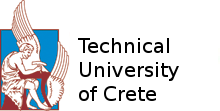1st November 2013, Chania, Greece
Technical University of Crete
You are here
Professor Bart van Arem
Short CV
 Prof Dr Bart van Arem is a full professor Transport Modelling at and chair of the department Transport and Planning at the Faculty of Civil Engineering and Geosciences at Delft University of Technology since 2009. He was educated in Applied Mathematics specializing in queueing theory at the University of Twente (Msc 1986, PhD 1990). He worked at the Netherlands Organization of Applied Scientific Research TNO from 1991-2009 and as a part time professor in Driver Assistance Systems at the University of Twente from 2003-2012. His research interest focuses on modelling driving behaviour and traffic flows in Intelligent Transport Systems, in which he has published numerous papers in journals and conference proceedings. He is an active member of the IEEE Intelligent Transport Systems Society, serving a general chair of the IEEE ITSC 2013 and IEEE IV 2008 conferences and various committees of the Transportation Research Board.
Prof Dr Bart van Arem is a full professor Transport Modelling at and chair of the department Transport and Planning at the Faculty of Civil Engineering and Geosciences at Delft University of Technology since 2009. He was educated in Applied Mathematics specializing in queueing theory at the University of Twente (Msc 1986, PhD 1990). He worked at the Netherlands Organization of Applied Scientific Research TNO from 1991-2009 and as a part time professor in Driver Assistance Systems at the University of Twente from 2003-2012. His research interest focuses on modelling driving behaviour and traffic flows in Intelligent Transport Systems, in which he has published numerous papers in journals and conference proceedings. He is an active member of the IEEE Intelligent Transport Systems Society, serving a general chair of the IEEE ITSC 2013 and IEEE IV 2008 conferences and various committees of the Transportation Research Board.
Traffic flow simulation of Vehicle Automation and Communication Systems
It used to be simple: we had human control of vehicles and we had controllers controlling the traffic. Now vehicles are becoming more advanced as controllers and distributed control is reshaping traffic flow properties, without intervention of any road operator whatsoever. We even observe that classical traffic flow patterns such as shock wave propagation change under the influence of intelligent vehicles. Vehicle automation is believed to lead to more efficient, safer and cleaner road traffic. Vehicle automation replaces human driving using advanced sensors, state estimation and prediction and vehicle actuation. Communication between vehicles and road side systems contributes to better situation awareness, in particular with respect to preview, and enables efficient vehicle following. This contribution will focus on the large scale dynamic behaviour of traffic flows with partially or highly automated vehicles. Traffic flow simulation will be used as the primary research method since it is not feasible to equip a sufficiently large number of real vehicle to study the dynamic traffic flow behaviour in real condition.
In the presentation we will provide a high level context of vehicle automation and communication system and formulate expectations of their potential impacts on traffic efficiency. Next, we will identify the requirements of traffic flow simulation models in order to identify the interaction between vehicle automation and communication systems and review suitable simulation environment. Case studies will be reviewed for several systems such as ACC, CACC, CCC. Particular attention will be paid to the role of the driver in applications that still require an active role of the driver. We will close with an outlook for future research.


